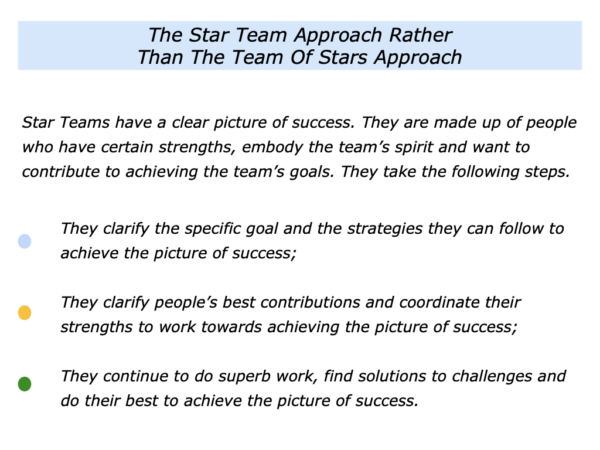
There are many ways to build fine teams. One approach is to build a star team rather than a team of stars. This piece focuses on the well-known concept that:
A star team may consistently perform better than a team of stars.
This is because people in star teams coordinate their strengths to consistently perform superb work. A team of stars will occasionally produce moments of brilliance but they may not do this consistently.
People in star teams aim to make their best contributions towards achieving the team’s goals. People in a team of stars may sometimes pursue their own agendas at the expense of achieving the team’s goals.
A team of stars can do great work. But it involves them choosing to combine their strengths to help the team to achieve its goals.
Star teams have a clear picture of success. They then focus on the following themes.
They Focus On Their People
They recognise it is vital to have the right people in the right places to enable the team to achieve its goals. They are made up of people who demonstrate certain characteristics.
They employ people: a) who have certain strengths; b) who embody the team’s spirit; c) who, most of all, want to contribute to achieving the team’s goal. Let’s explore these themes.
They employ people who
have certain strengths
Star teams employ people who have certain strengths. There are many ways to apply this approach when employing or recruiting people. The following pages explore some of these approaches.
The Strengths We Need For Achieving
The Picture Of Success Approach
Some teams do the following exercise to make sure they have the strengths required to achieve their goals.
They clarify the strengths that the team needs to achieve the picture of success;
They clarify the strengths they already have in the team to help them to achieve the picture of success;
They clarify the strengths they need to add to the team to help them to achieve the picture of success.
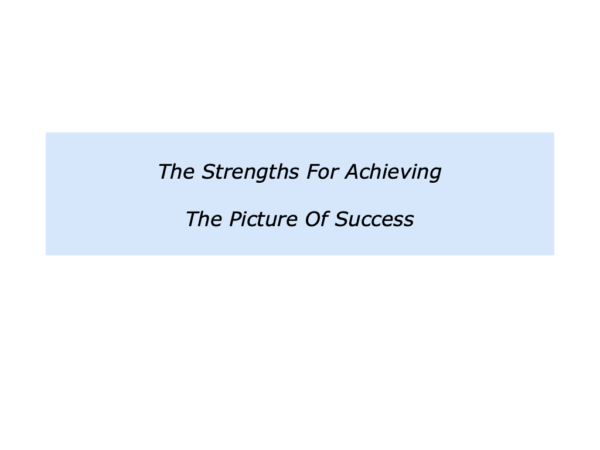
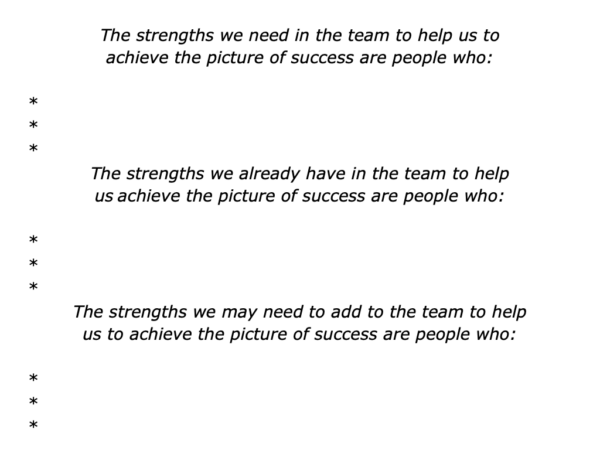
The Strengths A Person May
Add To The Team Approach
Star teams sometimes take another approach when considering people they can add to the team. This involves them exploring the following questions when focusing on a potential team member.
What are the person’s strengths – the activities in which they deliver As rather than Bs or Cs. How could they and we build on their strengths to help the team to achieve its goals?
What may be the potential pluses and minuses involved in employing the person? Bearing in mind these answers, do we want to move forward and explore the possibilities of the person contributing to the team?
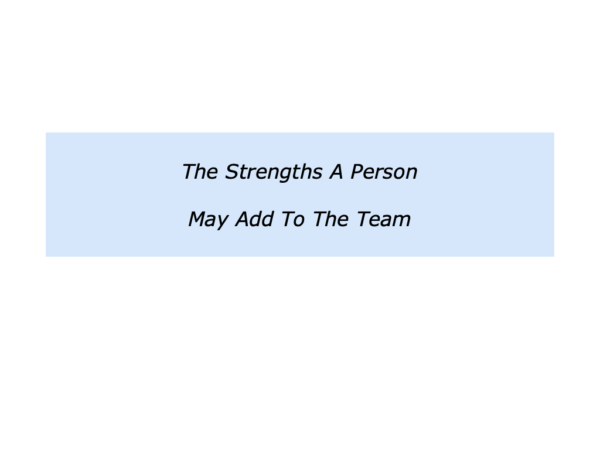
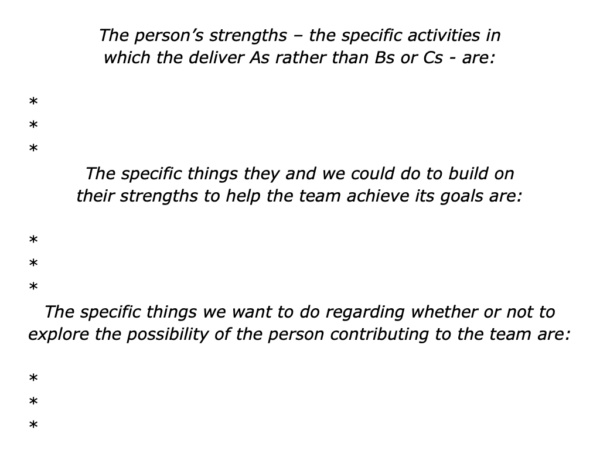
Star teams also consider another factor in deciding whether or not a person can contribute to the team.
They employ people who
embody the team’s spirit
Star teams are made up of people who have similarity of spirit and diversity of strengths. Spirit gets people so far. But it is the diversity of strengths that enables them to produce something special when it matters.
Diversity of spirit is a recipe for disaster. A person may have great strengths but if they behave in a negative way, for example, they can create collateral damage.
Star teams are clear on the spirit – the principles – they want people to demonstrate. They want characters rather than clones, however, and recognise that people will express the spirit in different ways.
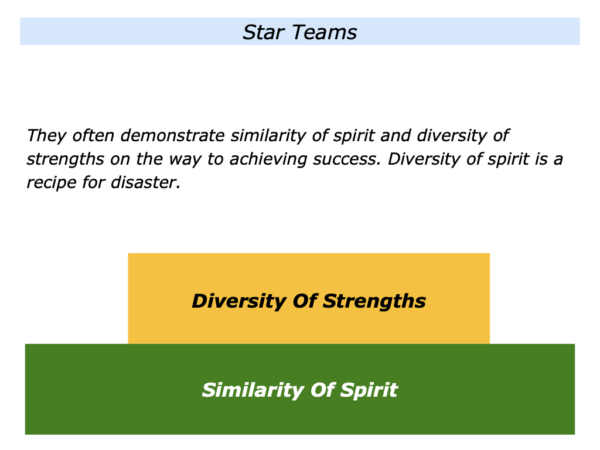
Such teams sometimes take the following steps to employ people who are likely to embody the team’s spirit. This involves them focusing on the following themes.
They start by defining the spirit – the principles – they want people to demonstrate. Some take the following approach.
They clarify the specific times in the past when people in the team have performed brilliantly;
They clarify the spirit – the principles – that people followed then and how they translated this into action;
They clarify the spirit – the principles – they would like people to follow in the future and how they can translate this into action.
Different teams will define different kinds of spirit or principles. Much depends, of course, on the kind of work they are doing.
A sports team may want its people to be positive, professional and aim to deliver peak performances. They will also look for people who want to apply their strengths to help the team to achieve success.
A hospice may want people who are compassionate and want to care for people nearing the end of their lives. They also look for people who can manage the emotions involved in doing such work.
Imagine that you lead a team and want to recruit people who demonstrate a certain kind of spirit. There are many ways to take this step.
One organisation I worked with took the following steps when interviewing people. They sent the candidate a booklet that described:
The spirit – the principles – they wanted people in people in the team to demonstrate;
The specific ways that people in the team had translated this spirit – these principles – into action in their work.
The candidate was invited to do some prework which they then presented at the interview. They were asked:
To describe a specific time when they had aimed to demonstrate this spirit – these principles – in their personal or professional life;
To describe the specific things they would aim to do to demonstrate this spirit – these principles – in their potential work for the team.
This sounds an enormous task but it was vital. Some candidates rose to the challenge whilst others did not. The organisation saw recruitment as one of its most important tasks, however, because they needed to employ people with the right attitude and abilities.
Many great teams take a similar approach. They also focus on the following theme when employing people.
They employ people who, most
of all, want to contribute to
helping the team to achieve its goals
Star teams believe it is vital for a person to really want to contribute to helping the team to achieve its goals. Bearing this in mind, they often take the following steps with talking with a person.
They explain the team’s goals and the strategies it will follow to work towards achieving the picture of success;
They explain the professional standards people are expected to follow when working towards achieving the picture of success;
They may explain, if appropriate, the potential contribution the person could make towards achieving the picture of success;
Such teams then invite the person to take time to reflect and do the following things.
First, to decide if they would like to contribute to the team. If the person does want to, they invite them to move on to the next stage
Second, to describe the potential contribution they would like to make towards helping the team to achieve its goals.
The person may sometimes need more information about the results they will be asked to deliver. But it can be good if they have a go at describing their potential contribution.
Star teams take this approach when interviewing people. They may also adapt it at certain times when having a conversation with a team member who may not be demonstrating the required professional standards.
Such teams employ people who have a volunteer mentality and who want to make the best contribution. They do not want to work with people who do not take this approach.
Imagine that a team has done what it can to get the right people in the right places. They then take the following step.
They Focus On
The Picture Of Success
Star teams believe in communicating the big picture and giving context to their people. They believe it is important for people to see how their work contributes towards achieving the team’s goals. Bearing this in mind, they present the following things to the team.
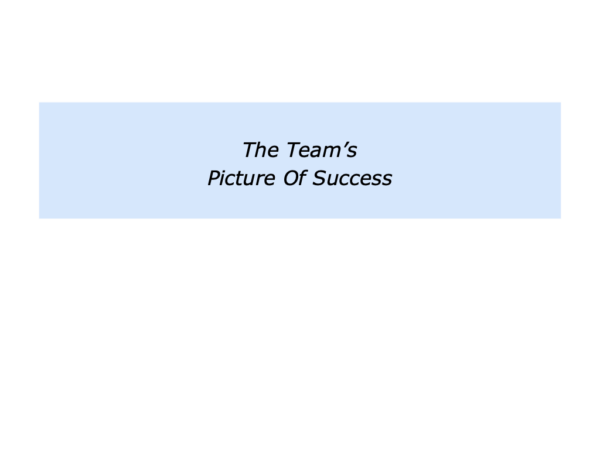
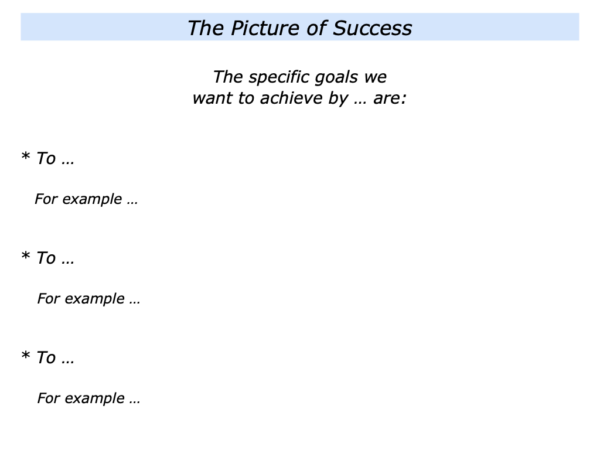
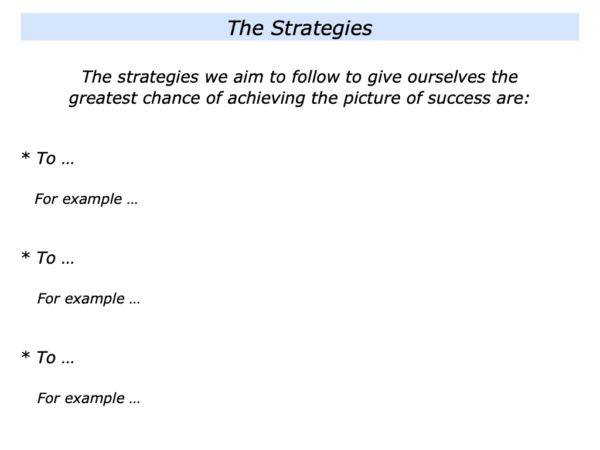
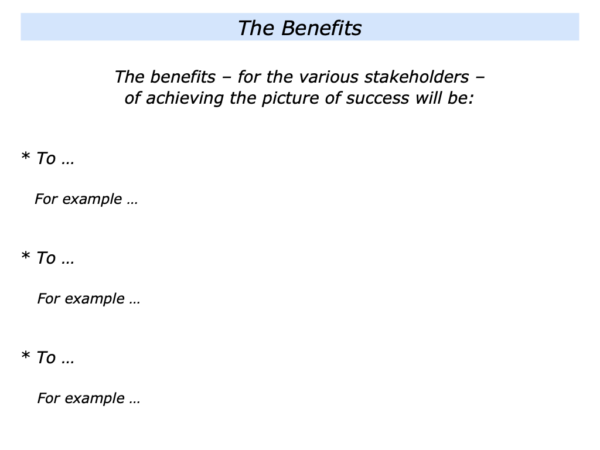
Some teams communicate the themes mentioned above. They then invite their people to go into groups, focus on the following themes and then present back their ideas.
Like About It – The specific things we like about it are …
Additions And Suggestions – The specific additions and suggestions we have are …
Concerns and Questions … The concerns and questions we have are …
Success Rating – The rating we would give regarding the team’s chances of achieving the goal and what we can do to improve the rating are …
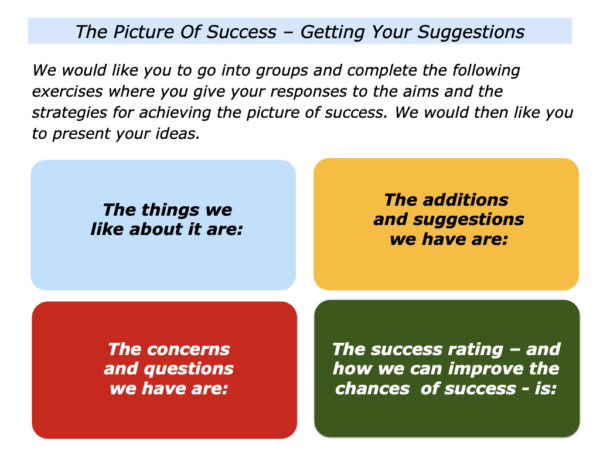
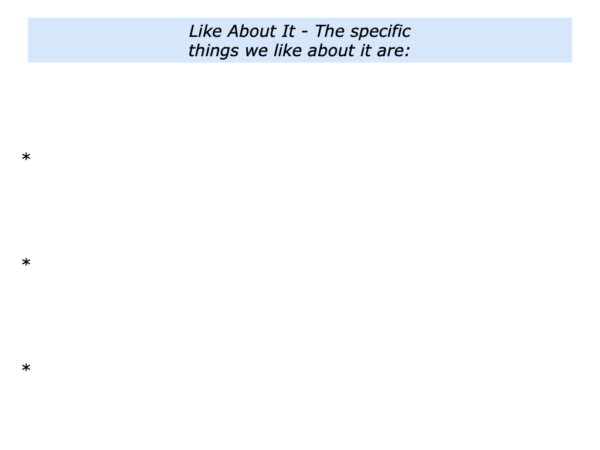
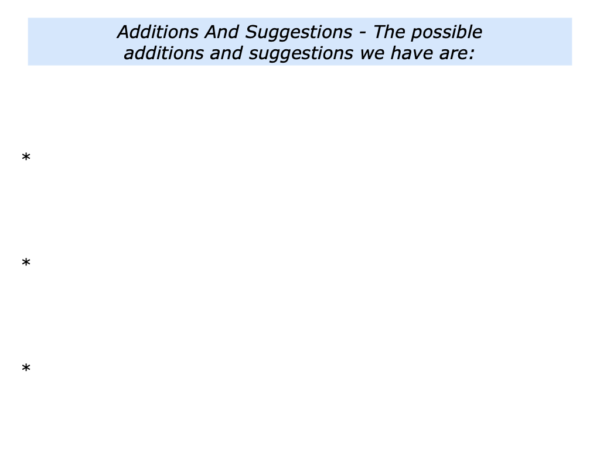
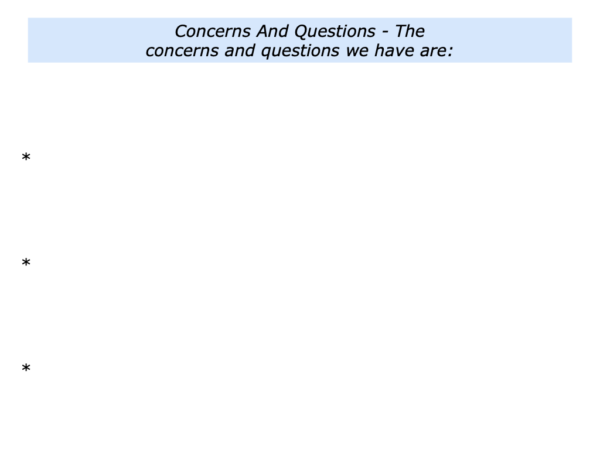
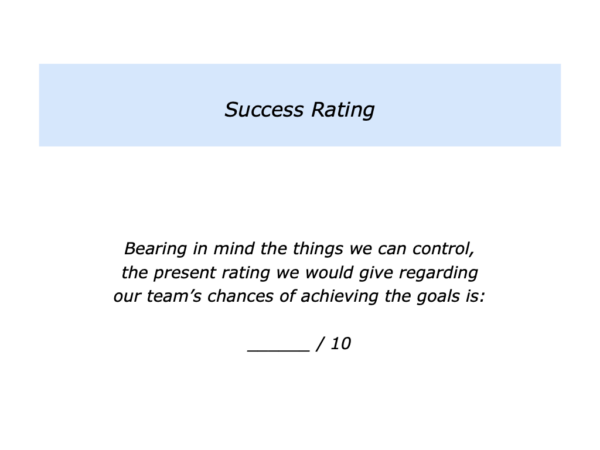
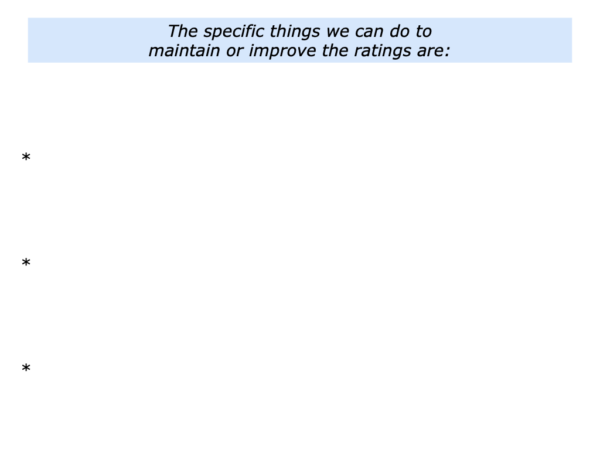
Imagine that a team has communicated the picture of success. It has involved its people and may have added some of their ideas to the final vision. They then take the following step.
They Focus On Coordinating
People’s Strengths To
Achieve The Picture Of Success
Star teams coordinate people’s strengths to work towards achieving the goals. Different teams do this in different ways. Some teams take the following steps.
They make clear contracts with people
about their best contributions
towards achieving the team’s goals
This involves each person doing the following exercise. Bearing in mind the team’s picture of success and their strengths, it invites them to make clear contracts with their manager in the following areas.
The specific outcomes they will deliver – and by when – towards achieving the team’s goals;
The specific support they would like and the support they will give others when working towards the team’s goals;
The specific ways they will keep people informed about their progress towards delivering their contribution towards the team’s goals.
There are many ways to take this step. One approach is for the person to do the following exercises and agree on their contribution with their manager.

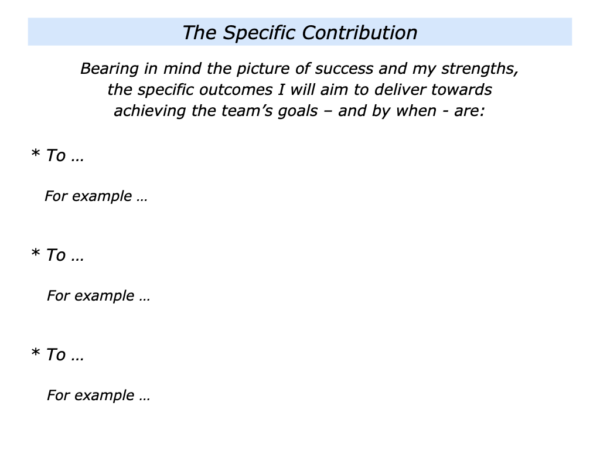
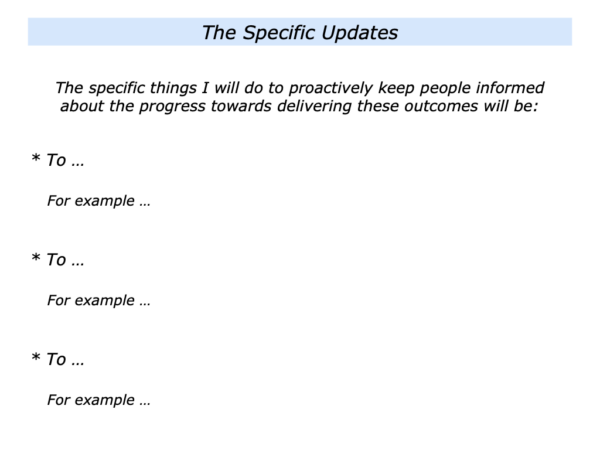
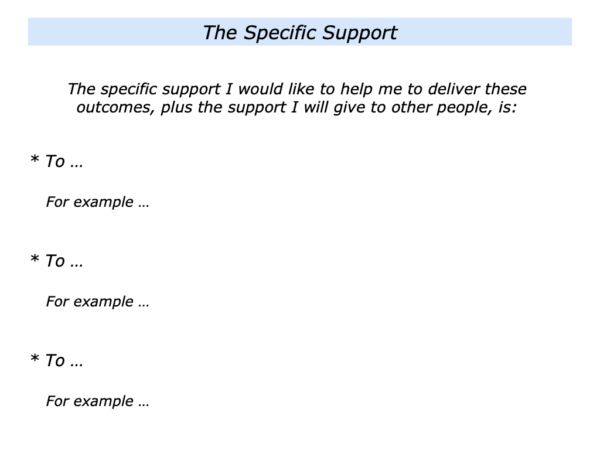
They coordinate people’s strengths to work
towards achieving the picture of success
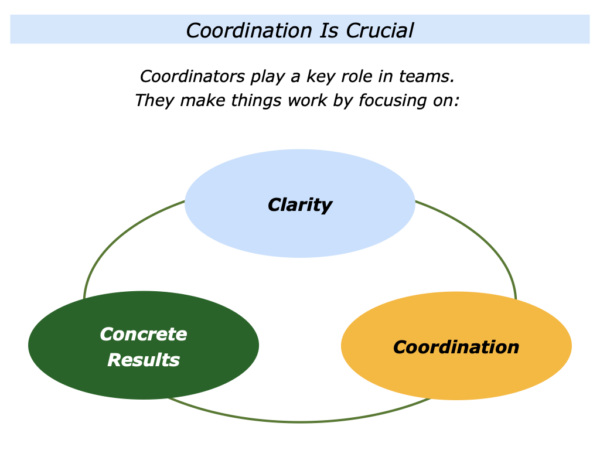
Star teams often have great coordinators. Such people are often good at connecting with people and orchestrating their strengths to deliver the desired concrete results. They often focus on the following themes.
Clarity
Coordinators are good at managing upwards and clarifying the real results the leader wants to achieve. They then communicate this clarity to other people in the organisation.
Sometimes this involves continuing to communicate the organisation’s purpose, principles and picture of success. Sometimes it may involve focusing on a specific piece of work and clarifying the real results to achieve.
Coordination
Good coordinators make things work. They often do this by harnessing people’s strengths to achieve the agreed picture of success. They aim to manage by outcomes rather than by tasks.
They start by explaining the big picture. This is especially vital with knowledge workers who want to know the context. They then take the following steps before making clear contracts with people:
They remind people about the team’s aims and strategies for achieving the picture of success;
They explain where the specific piece of work fits into achieving the picture of success;
They explain the real results – the outcomes – to achieve by doing the piece of work;
They then take these steps to coordinate people’s strengths.
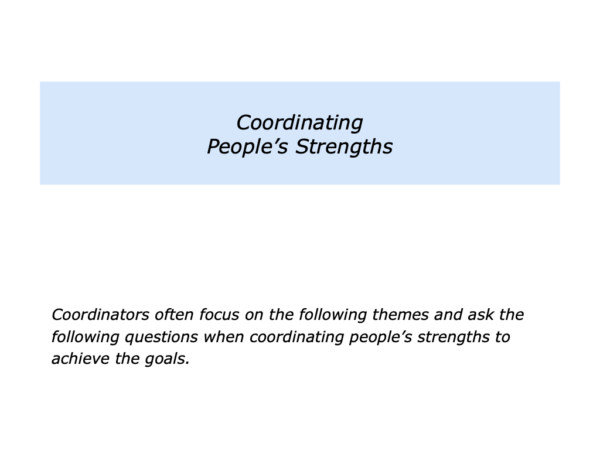
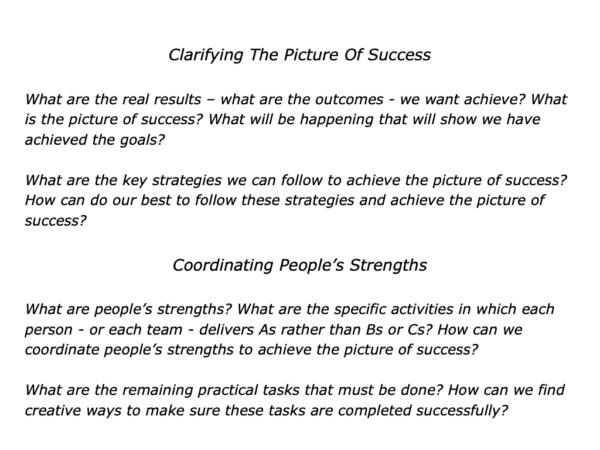
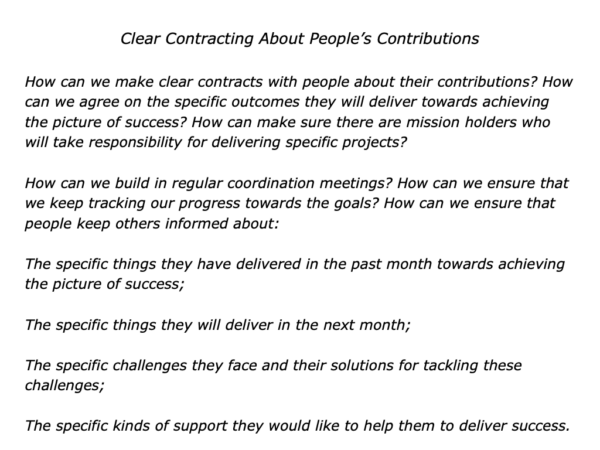
Concrete Results
Good coordinators get some early wins rather than embark on long process analyses. Success breeds success. It also buys time to tackle the more long-standing challenges.
They keep in touch with the leader and see their role as being proactive rather than that of being a glorified progress chaser.
They have regular meetings with the leader to look ahead to the next week, the month and the next quarter. They clarify the challenges facing the team and agree on the potential solutions.
Good coordinators ensure that people proactively keep them informed about their progress towards achieving the goals. They set up sessions where each person continually reports on the following themes.
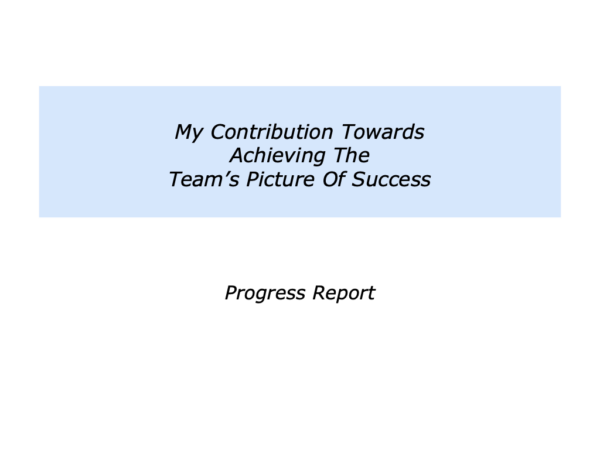

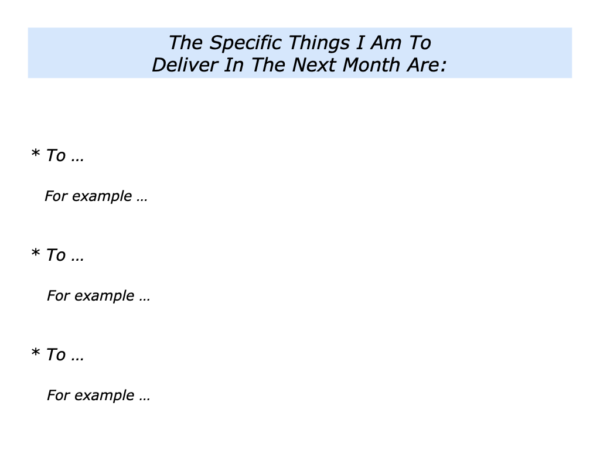

Imagine that a team is following elements of this approach. They then take the next step.
They Focus On Achieving
The Picture Of Success
Star teams encourage their people to perform superb work. They also encourage them to find solutions to challenges and do their best to achieve the picture of success. Different teams do this in different ways.
One organisation I worked with had a dedicated room where people constantly updated the progress towards achieving the goal. It had charts that covered the following areas.
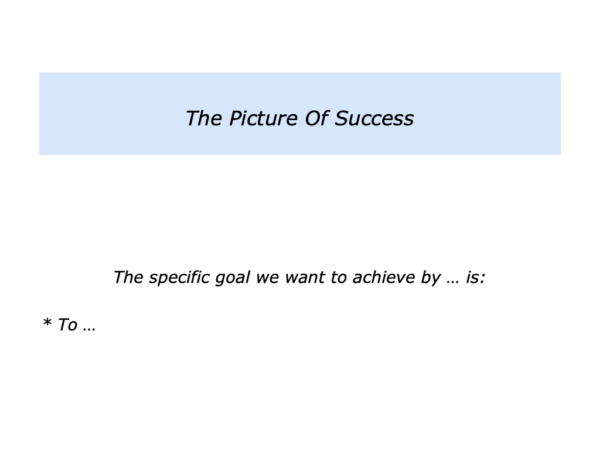
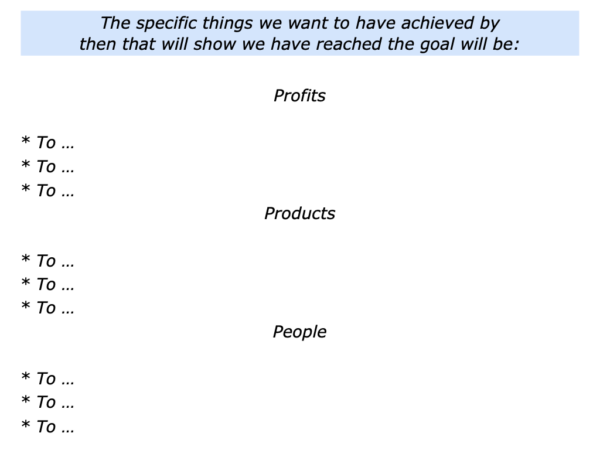
The other walls had the following charts that described the current state of play regarding various activities.
The Green Zone
People listed the things that were going well. They also provided concrete suggestions regarding how to maintain or build on these activities.
Great workers build on what is working. If things are going well with a particular customer, for example, they explore how to continue providing great service. This can lead to developing the relationship even further.
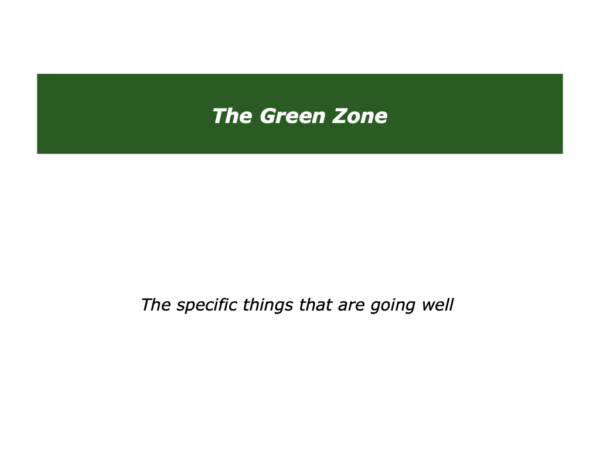
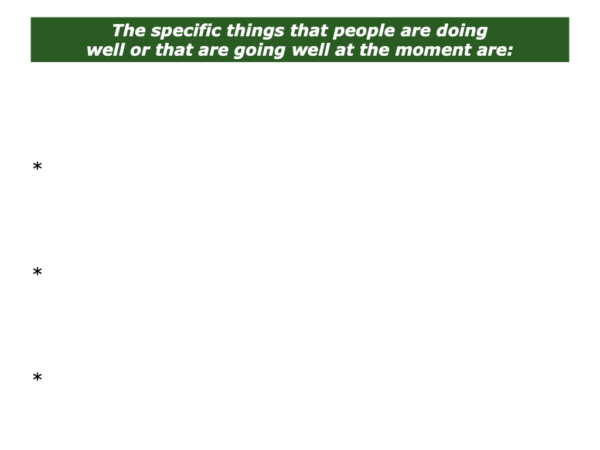
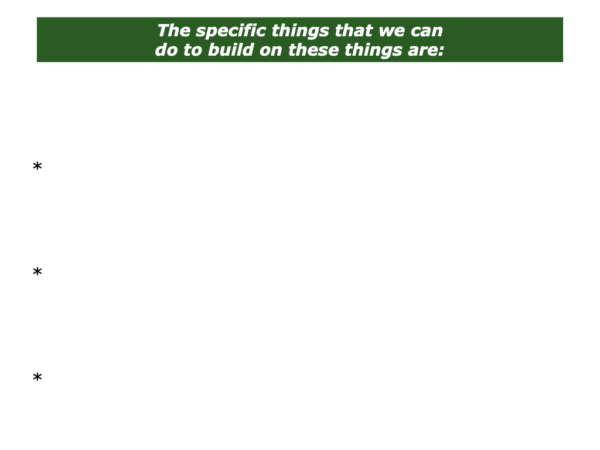
The Amber Zone
People described where there were warning signs. They also provided suggestions regarding how to improve these activities.
Great workers worry about things that are in the amber zone. They are concerned that, unless these issues are addressed, these may quickly slide into the red zone. So they focus on how to move these activities more towards the green zone.
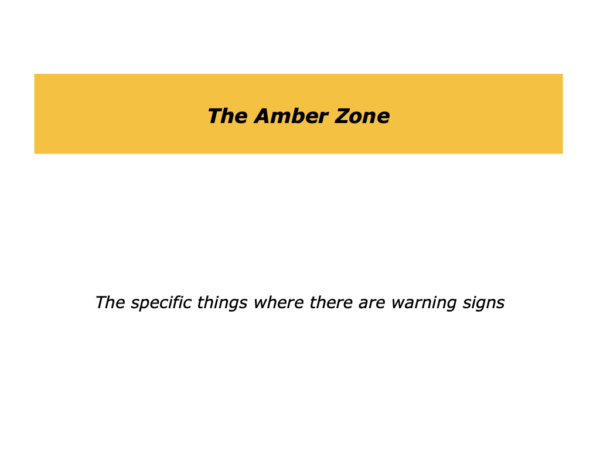
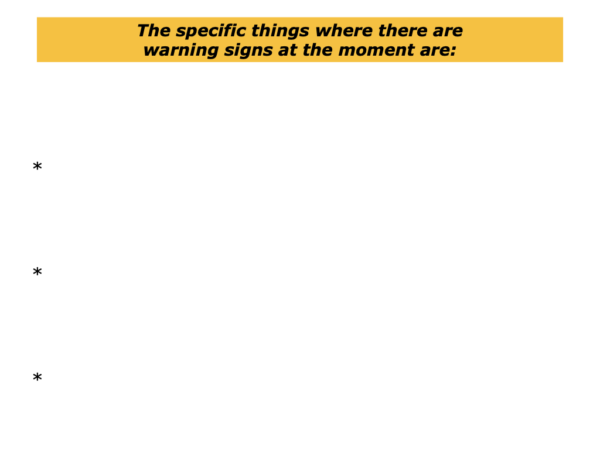
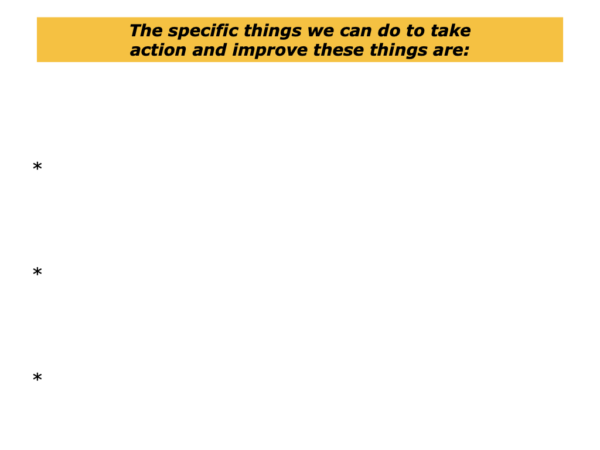
The Red Zone
People listed the things that were going badly and gave suggestions regarding how to improve these activities. These could involve making radical improvements or for taking key decisions.
Great workers think ahead to ensure that things do not slide into the red zone. Crises do occur, of course, so then it is vital to find positive solutions.
There may be some issues, however, that are continually falling into the red zone. If systems are breaking down, for example, these may well need replacing.
A more challenging issue could be if a particular customer continually makes life difficult. Certainly it is vital to do whatever possible to provide great service. In some instances, however, a customer may prove impossible to please.
They may also prove to be a massive drain on resources. In such cases it may mean deciding to move on from the customer. This can be a difficult but necessary decision.
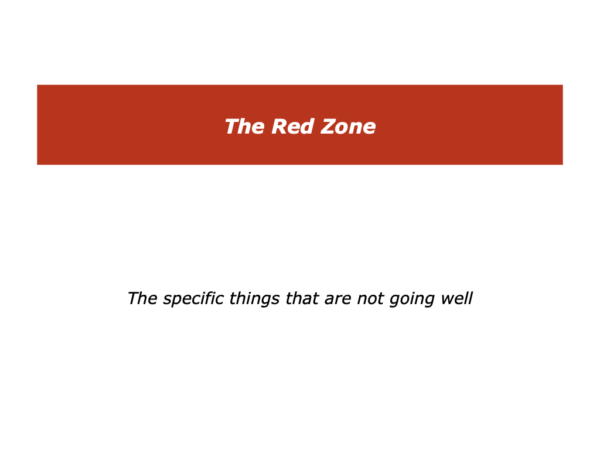
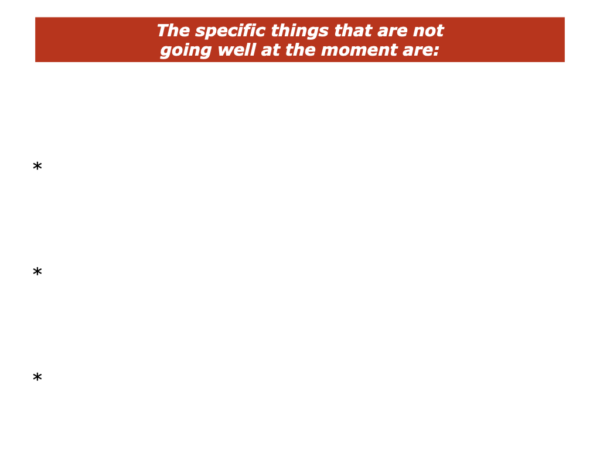
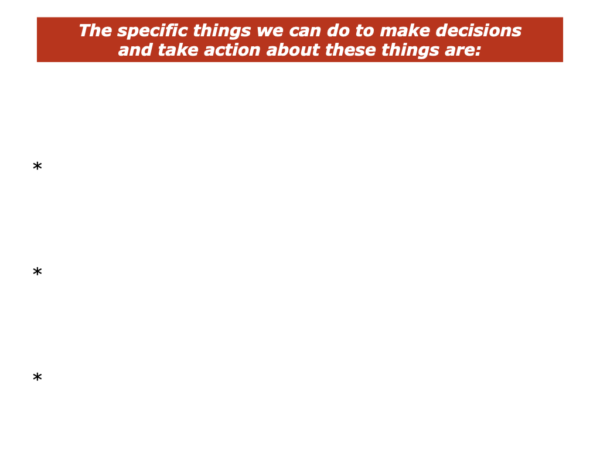
The Blue Zone
The organisation also went further and added another area called the blue zone. This was the space for both practical and imaginative ideas.
People listed the specific ideas, suggestions and other things that it might be worth considering to help the team shape a successful future. This led to some of the ideas being implemented and delivering positive results.
Great workers continually look for ways to improve. It can be useful to create different forums for exploring these ideas and then translating some of these into action.
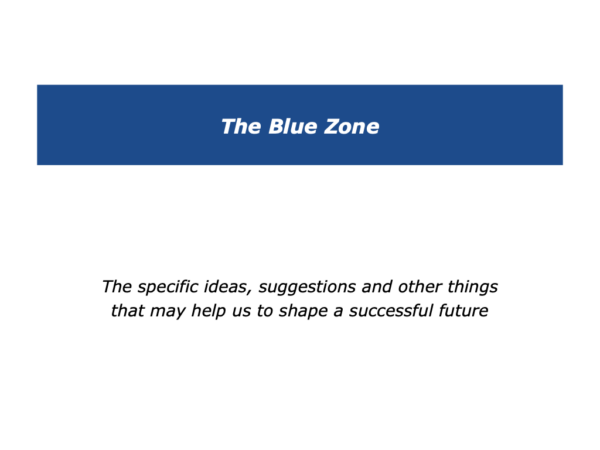
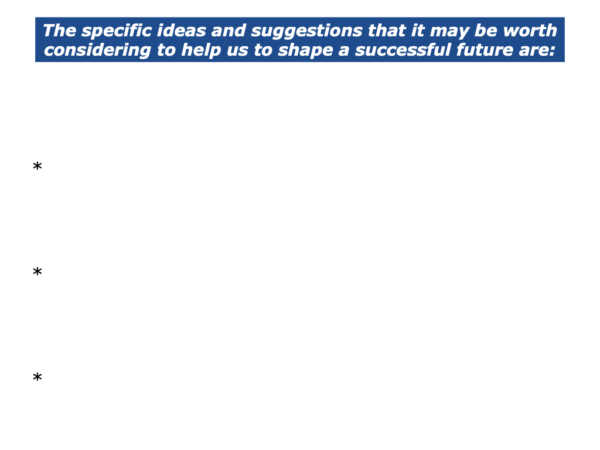
There are many ways to build fine teams. One approach is to build a star team rather than a team of stars. This piece has focused the theme that:
A star team may consistently perform better than a team of stars.
This is because people in star teams coordinate their strengths to consistently perform superb work. A team of stars will occasionally produce moments of brilliance, but they may not do this consistently.
Let’s return to your own work. Looking ahead, can you think of a situation where you may want to follow elements of the star team approach? How can you do this in your own way?
If you wish, try tackling the exercise on this theme. This invites you to complete the following sentences.
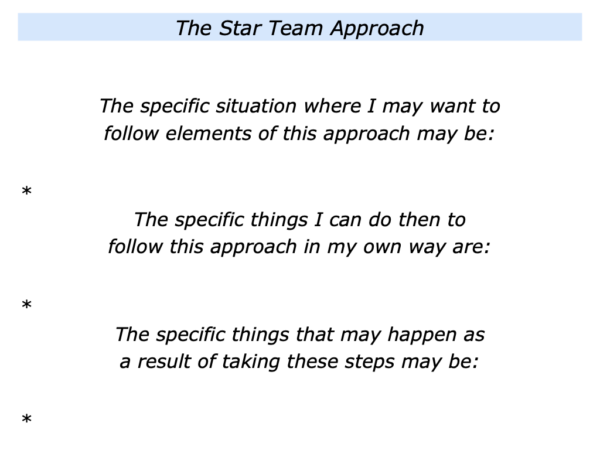






Leave a Reply